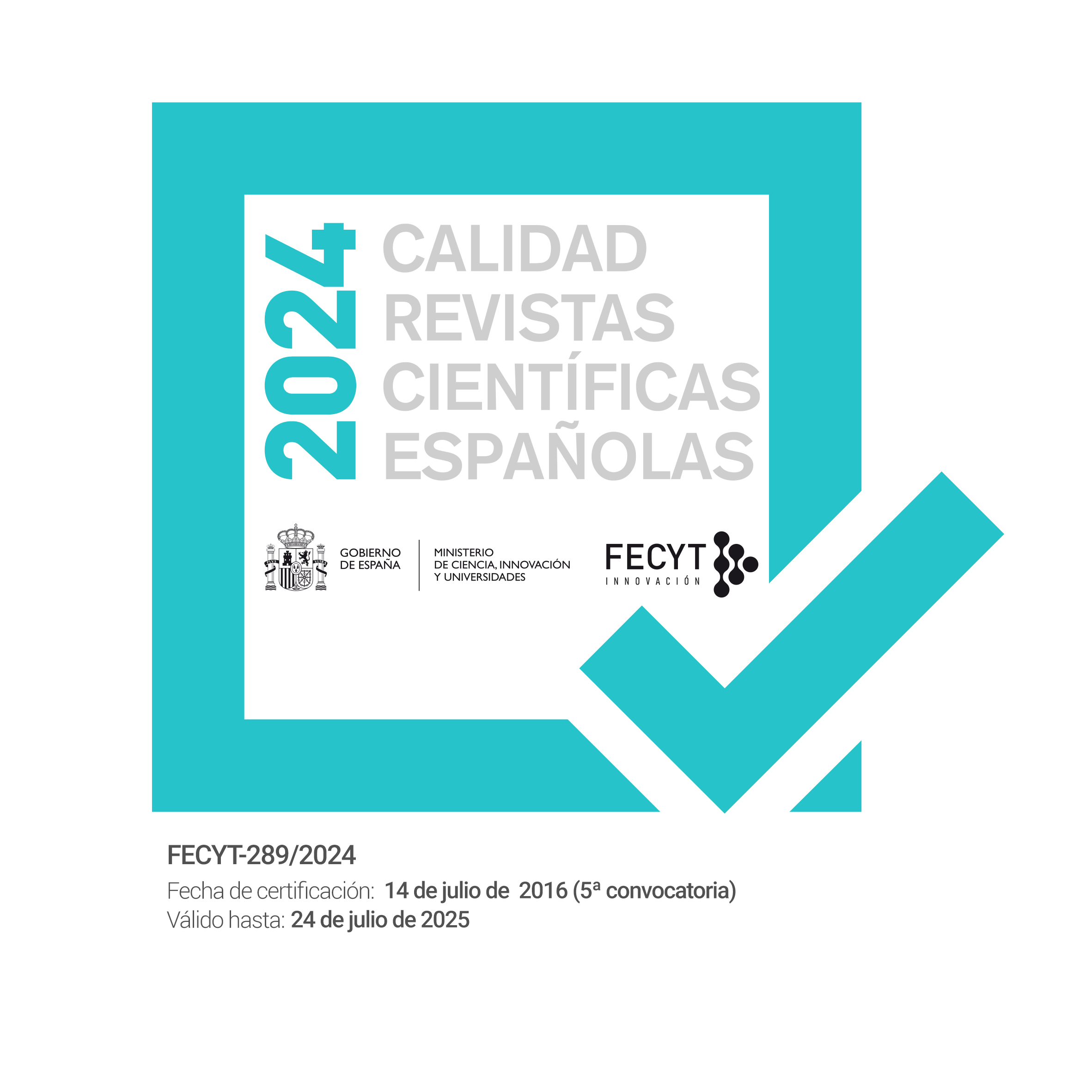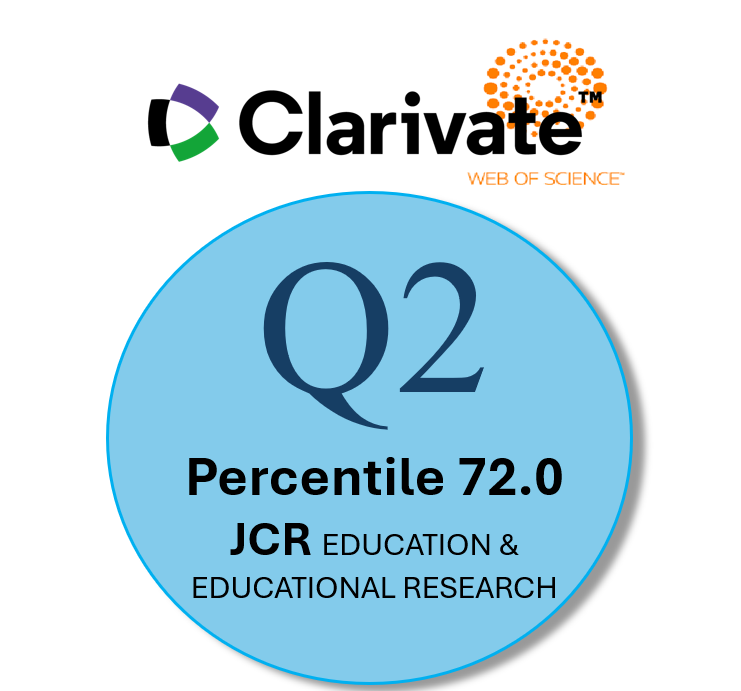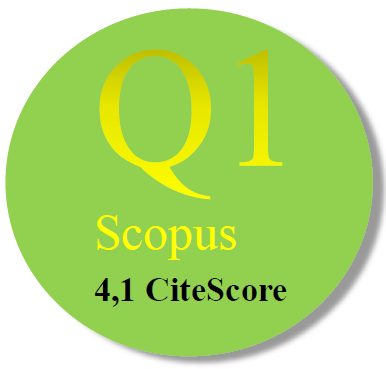Digital Storytelling in the 2D modality and with augmented reality for the development of creativity in early childhood education
Supporting Agencies
- Contrato de N°IBA-CS-08-2020-UNSA
Abstract
The use of Digital Storytelling in education presents great benefits given its multiformat nature and the motivation it awakens in students, especially at the early childhood level. The purpose of this research is to analyze the use of Digital Storytelling (DST) in its 2D and Augmented Reality versions and to establish comparisons between both possibilities for the development of creativity at the preschool level. The type of design of this research was "pre-experimental" pretest-posttest type. The participants were 70 children from the Peruvian "casa cuna", whose ages corresponded to 5 and 6 years old. The 44.3% were girls and 55.7% were boys. A test of children's creativity was applied. The main result obtained was the increase in the scores achieved in the post-test in the 2D and 3D modalities, with more significant differences in the DST experience with augmented reality.
Downloads
-
Abstract2699
-
PDF (Español (España))1694
References
Afnan; Muhammad, K.; Khan, N.; Lee, M.-Y.; Imran, A.S.; Sajjad, M. School of the Future: A Comprehensive Study on the Effectiveness of Augmented Reality as a Tool for Primary School Children’s Education. Appl. Sci. 2021, 11, 5277. https://doi.org/10.3390/ app11115277
Alfonso-Benlliure, V., & Santos, M.R. (2016). Creativity development trajectories in Elementary Education: Differences in divergent and evaluative skills. Thinking Skills and Creativity, 19, 160-174.
Alfonso-Benlliure, V., Meléndez, J.C., & Garcia-Ballesteros, M. (2013). Evaluation of a creativity intervention program for preschoolers. Thinking Skills and Creativity, 10, 112-120.
Aydoğdu, F. (2021). Augmented reality for preschool children: An experience with educational contents. British Journal of Educational Technology, 00, 1–23. https://doi.org/10.1111/bjet.13168
Barkhaya, N. M., Halim, N. D., y Yahaya, N. (2018). The Importance of Augmented Reality Application for Children's Development During Preschool Years. Advanced Science Letters, 24(11), 7935-7(4). https://doi.org/10.1166/asl.2018.12460
Barroso, J., Cabero, J. y Valencia, R. (2018). Uso educativo de la RA: Experiencias en España y México. Enseñanza & Teaching, 36(2), 7-29
Benmayor, R. (2008). Digital Storytelling as a Signature Pedagogy for the New Humanities. Arts and Humanities in Higher Education, 7(2), 188–204. https://doi.org/10.1177/1474022208088648.
Blázquez, F., Alonso, L. y Yuste, R. (2017). La evaluación en la era digital. Madrid: Síntesis.
Borislavovna Borislova, N. (2017). Desarrollo de la creatividad en la primaria a partir del cuento musical. RIDE. Revista Iberoamericana para la Investigación y el Desarrollo Educativo, 7(14), 265-298. https://doi.org/10.23913/ride.v7i14.284
Borislova, N.B., & Hernández, G.M. (2019). Desarrollo de la creatividad infantil con el apoyo del cuento musical.
Cabero, J. y García, F. (2016). (coords.). Realidad aumentada. Tecnología para la formación. Madrid: Síntesis
Cabero, J. y otros (coords.) (2018). La realidad aumentada como herramienta educativa. Aplicación a la educación infantil, primaria, secundaria y bachillerato. Madrid: Paraninfo.
Cabero, J., Batanero, J.M. y Barroso, J. (2019). Adoption of augmented reality technology by university students. Heliyon 5 (2019) e01597
Casado, Y.; Llamás Salguero, F.; López-Fernández, V. Inteligencias múltiples, creatividad y lateralidad, nuevos retos en metodologías docentes enfocadas a la innovación educativa. Reidocrea, 4: 343-358 (2015). http://hdl.handle.net/10481/38548.
Codesal, M.B. y López, S. (2018). Entra en tu juego: realidad virtual y storytelling, Aula de Innovación educativa, 269, 17-21.
Cortés, P. y González, B. (coords.) (2020). El uso de las narrativas en la enseñanza universitaria. Experiencias docentes y perspectivas metodológicas. Barcelona: Octaedro.
Crespo-Cárdenas, V., & Cárdenas-Cordero, N. (2021). Storytelling como estrategia de enseñanza-aprendizaje para desarrollar el lenguaje en Educación Inicial mediante cuentos. CIENCIAMATRIA, 7(13), 122-137. https://doi.org/10.35381/cm.v7i13.475.
De Jager, A., Fogarty, A., Tewson, A., Lenette, C., & Boydell, K. (2017). Digital Storytelling in Research: A Systematic Review. The Qualitative Report, 22(10), 2548-2582. https://doi.org/10.46743/2160-3715/2017.2970
Del Moral Pérez, M. E. D. y Bellver Moreno, M. D. C. (2017). APP lúdicas infantiles: creación de digital storytelling y desarrollo de la creatividad. Actas del V Congreso Internacional de Videojuegos y Educación (CIVE'17). https://riull.ull.es/xmlui/bitstream/handle/915/6788/CIVE17_paper_71.pdf?sequence=1
Del Moral Pérez, M. E., Martínez, L. V., & Piñeiro, M. D. R. N. (2018). Percepción docente del desarrollo emocional y creativo de los escolares derivado del diseño colaborativo de digital storytelling. Educación XX1, 21(1), 345-374.
Del Moral, M., Villalustre, L. y Piñeiro, M.R. (2018). Percepción docente del desarrollo emocional y creativo de los escolares derivado del diseño colaborativo de Digital Storytelling. Educación XX1, 21(1), 345-374. https://doi.org/10.5944/educxx1.20202.
Del Moral, M., Villalustre. L. y Neira, M.R. (2016). Habilidades sociales y creativas promovidas con el diseño colaborativo de digital storytelling en el aula. Digital Education Review, 30. http://greav.ub.edu/der/
Del Moral-Pérez, M. E., Villalustre-Martínez, L., & Neira-Piñeiro, M. del R. (2016). Relatos digitales: activando las competencias comunicativa, narrativa y digital en la formación inicial del profesorado. Ocnos. Revista De Estudios Sobre Lectura, 15(1), 22-41. https://doi.org/10.18239/ocnos_2016.15.1.923
Doolani, S., Owens, L., Wessels, C. y Makedon, F. (2020). vIS: An Immersive Virtual Storytelling System for Vocational Training. Applied sciences, 10, 8143. https://doi.org/10.3390/app10228143.
Fleer, M. (2018). Digital animation: New conditions for children’s development in play-based setting. British Journal of Educational Technology, 49(5), 943-958. https://doi.org/10.1111/bjet.12637.
Gil, A. (2015). Narrativa aumentada. Anuario de Literatura Comparada, 5, 45-74.
Hermann, A. (2018). Innovación, tecnologías y educación: las narrativas digitales como estrategias didácticas. Revista Killkana Sociales, 2(2), 31-38.
Hung, C.M., Hwang, G.-J., & Huang, I. (2012). A Project-based Digital Storytelling Approach for Improving Students' Learning Motivation, Problem-Solving Competence and Learning Achievement. Educational Technology & Society, 15 (4), 368–379.
Hurtado-Mazeyra, A., Alejandro-Oviedo, M., Núñez-Pacheco, R., Guillén-Chávez, E.P., Afata-Ataucuri, E., & Ancasi-Villagomez, G. (2021). Digital Storytelling with Stop Motion for the Development of Competencies in University Students. 4th International Conference on Education Technology Management, ICETM 2021. pp.148 – 154. https://doi.org/10.1145/3510309.3510333
Istenic, A., Cotic, M., Solomonides, I. y Volk, M. (2016). Engaging preservice primary and preprimary school teachers in digital storytelling for the teaching and learning of mathematics. British Journal of Educational Technology, 47, 1, 29–50. https://doi.org/10.1111/bjet.12253
Johnson, L., Adams Becker, S., Cummins, M., Estrada, V., Freeman, A., y Hall, C. (2016). NMC Horizon Report: 2016. Higher Education Edition. Austin, Texas: The New Media Consortium.
Kocaman-Karoglu, A. (2015). Telling stories digitally: an experiment with preschool children. Educational Media International, 52(4), 340–352. https://doi.org/10.1080/09523987.2015.1100391.
Kumpulainen, K., Byman, J., Renlund, J., Wong, C.C. (2020). Children’s augmented storying in, with and for nature. Education Sciences, 10 (6), art. no. 149. https://doi.org/ 10.3390/educsci10060149.
Llamazares, M.T. y Alonso-Cortés, M.D. (2016). Lectura compartida y estrategias de comprensión lectora en educación infantil. Revista Iberoamericana de Educación, 71, 151-172. https://doi.org/10.35362/rie7109
López-Ornelas, E., & Abascal-Mena, R. (2018). An Interactive Digital Storytelling to Identify Emotions and Consequences in the Elementary School Child. Lecture Notes in Computer Science, 218–230. https://doi.org/10.1007/978-3-319-91806-8_17.
Maureen, I. Y., van der Meij, H., & de Jong, T. (2018). Supporting Literacy and Digital Literacy Development in Early Childhood Education Using Storytelling Activities. International Journal of Early Childhood, 50(3), 371–389. https://doi.org/10.1007/s13158-018-0230-z
Niemi, H. & Multisilta, J. (2016) Digital storytelling promoting twenty-first century skills and student engagement, Technology, Pedagogy and Education, 25(4), 451-468. https://doi.org/10.1080/1475939X.2015.1074610.
Novak, E. (2015). A critical review of digital storyline-enhanced learning. Education Tech Research Dev, 63, 431–453. https://doi.org/10.1007/s11423-015-9372-y.
Oakley, G., Wildy, H., & Berman, Y. (2018). Multimodal digital text creation using tablets and open-ended creative apps to improve the literacy learning of children in early childhood classrooms. Journal of Early Childhood Literacy, 146879841877917. https://doi.org/10.1177/1468798418779171
Observatorio de Innovación Educativa (2017). Storytelling. Monterrey: Tecnológico de Monterrey.
Ohler, J. (2013). Digital storytelling in the classroom: New media pathways to literacy, learning and creativity. Thousand Oaks, CA: Corwin Press. https://dx.doi.org/10.4135/9781452277479.
Pan, Z., López, M., Li, C., & Liu, M. (2021). Introducing augmented reality in early childhood literacy learning. Research in Learning Technology, 29. https://doi.org/10.25304/rlt.v29.2539
Papadimitriou, E., Kapaniaris, A., Zisiadis, D., & Kalogirou, E. (2013). Digital Storytelling in Kindergarten: An Alternative Tool in Children’s Way of Expression. Mediterranean Journal of Social Sciences. https://doi.org/10.5901/mjss.2013.v4n11p389.
Pavlik, J. (2018). Experiential Media and Transforming Storytelling: A Theoretical Analysis. Studies: JOCIS, 3, 46-67. http://hdl.handle.net/10760/34381
Peñalba, E., Samaniego, Ch. y Romero, Sh. (2020). Digital storytelling: a tool for promoting historical understanding among college students. Research in Learning Technology, 28, 2348. https://doi.org/10.25304/rlt.v28.2348.
Preradovic, N., Lesin, G. y Boras, D. (2016). Introduction of Digital Storytelling in Preschool Education: a Case Study from Croatia. Digital Education Review, 30, 94-105. https://doi.org/10.1344/der.2016.30.94-105
Purnama, S., Ulfah , M., Ramadani , L., Rahmatullah , B., & Ahmad , I. F. (2022). Digital Storytelling Trends in Early Childhood Education in Indonesia: A Systematic Literature Review. Jurnal Pendidikan Usia Dini, 16(1), 17 - 31. https://doi.org/10.21009/JPUD.161.02
Rahiem, M. (2021). Storytelling in early childhood education: Time to go digital. ICEP 15, 4 (2021). https://doi.org/10.1186/s40723-021-00081-x.
Rivas Rebaque, B., Gértrudix Barrio, F., & Gértrudix-Barrio, M. (2021). Análisis sistemático sobre el uso de la Realidad Aumentada en Educación Infantil . Edutec. Revista Electrónica De Tecnología Educativa, (76), 53-73. https://doi.org/10.21556/edutec.2021.76.2053
Robin, B. (2016). The Power of Digital Storytelling to Support Teaching and Learning. Digital Education Review, 30, http://greav.ub.edu/der/.
Romo, M., Alfonso-Benlliure, V., & Sanchez-Ruiz, M. J. (2016). El test de creatividad infantil (TCI): evaluando la creatividad mediante una tarea de encontrar problemas. Psicología educativa, 22(2), 93-101. https://doi.org/10.1016/j.pse.2016.01.005.
Romo, M., Benlliure, V. y Sánchez-Ruiz, M.J. (2008). Test de Creatividad Infantil. Evaluación del pensamiento creativo de educación primaria. Ediciones TEA.
Rosales, S. (2016). Uso del relato digital (digital storytelling) en la educación. influencia en las habilidades del alumnado y del profesorado. Alicante: Faculktad de Educación, tesis doctoral inédita.
Rubegni, E., & Landoni, M. (2018). How to Design a Digital Storytelling Authoring Tool for Developing Pre-Reading and Pre-Writing Skills. Proceedings of the 2018 CHI Conference on Human Factors in Computing Systems - CHI ’18. https://doi.org/10.1145/3173574.3173969.
Rubino, I. (2018). Exploring the values of writing collaboratively through a digital storytelling platform: a mixed-methods analysis of users’ participation, perspectives and practices. Interactive Learning Environments, 26(7), 882-894. https://doi.org/10.1080/10494820.2017.1419499
Rutta, C. B., Schiavo, G., Zancanaro, M., & Rubegni, E. (2020, June). Collaborative comic-based digital storytelling with primary school children. In Proceedings of the Interaction Design and Children Conference, 426-437. https://doi.org/10.1145/3392063.3394433
Sánchez-Vera, Mª, Solano-Fernández, I.Mª., & Recio Caride, S. (2019). El storytelling digital a través de vídeos en el contexto de la educación infantil. Pixel-Bit. Revista de Medios y Educación, 54, 165-184. https://doi.org/10.12795/pixelbit.2019.i54.09.
Sans, A. (2004). Métodos de investigación de enfoque experimental, en R. Bisquerra (coord..). Metodología de la investigación educativa. La Muralla, 167-193.
Siegel, S. (1976). Estadística no paramétrica. Trillas.
Villalustre, L. y Del Moral, M. (2014). Digital storytelling: una nueva estrategia para narrar historias y adquirir competencias por parte de los futuros maestros. Revista Complutense de Educación, 25 (1), 115-132. https://doi.org/10.5209/rev_RCED.2014.v25.n1.41237.
Woo, C. (2017). The effects of digital storytelling on student achievement, social presence, and attitude in online collaborative learning environments. Interactive Learning Environments, 25(3), 412-427. https://doi.org/10.1080/10494820.2015.1135173
Wu J., & Chen V.D.-T. (2020). A systematic review of educational digital storytelling, Computers & Education. https://doi.org/10.1016/j.compedu.2019.103786.
Wulandari, R. A., Hafidah, R., & Pudyaningtyas, A. R. (2020, September). The Effect of Augmented Reality (AR) Flashcard on Early Literacy of Early Childhood. In Proceedings of the 4th International Conference on Learning Innovation and Quality Education (pp. 1-5).
Yilmaz, M. M., & Siğirtmaç, A. (2020). A material for education process and the Teacher: the use of digital storytelling in preschool science education. Research in Science & Technological Education, 1–28. https://doi.org/10.1080/02635143.2020.1841148.
Yilmaz, R. M., & Goktas, Y. (2017). Using augmented reality technology in storytelling activities: examining elementary students’ narrative skill and creativity. Virtual Reality, 21(2), 75-89. https://doi.org/10.1007/s10055-016-0300-1
Yilmaz, R. M., Kucuk, S., & Goktas, Y. (2017). Are augmented reality picture books magic or real for preschool children aged five to six? British Journal of Educational Technology, 48(3), 824-841. https://doi.org/10.1111/bjet.12452
Copyright (c) 2023 Distance Education Journal

This work is licensed under a Creative Commons Attribution-NonCommercial 4.0 International License.
Las obras que se publican en esta revista están sujetas a los siguientes términos:
1. El Servicio de Publicaciones de la Universidad de Murcia (la editorial) conserva los derechos patrimoniales (copyright) de las obras publicadas, y favorece y permite la reutilización de las mismas bajo la licencia de uso indicada en el punto 2.
2. Las obras se publican en la edición electrónica de la revista bajo una licencia Creative Commons Reconocimiento-NoComercial-SinObraDerivada 3.0 España (texto legal). Se pueden copiar, usar, difundir, transmitir y exponer públicamente, siempre que: i) se cite la autoría y la fuente original de su publicación (revista, editorial y URL de la obra); ii) no se usen para fines comerciales; iii) se mencione la existencia y especificaciones de esta licencia de uso.
3. Condiciones de auto-archivo. Se permite y se anima a los autores a difundir electrónicamente las versiones pre-print (versión antes de ser evaluada) y/o post-print (versión evaluada y aceptada para su publicación) de sus obras antes de su publicación, ya que favorece su circulación y difusión más temprana y con ello un posible aumento en su citación y alcance entre la comunidad académica. Color RoMEO: verde.













